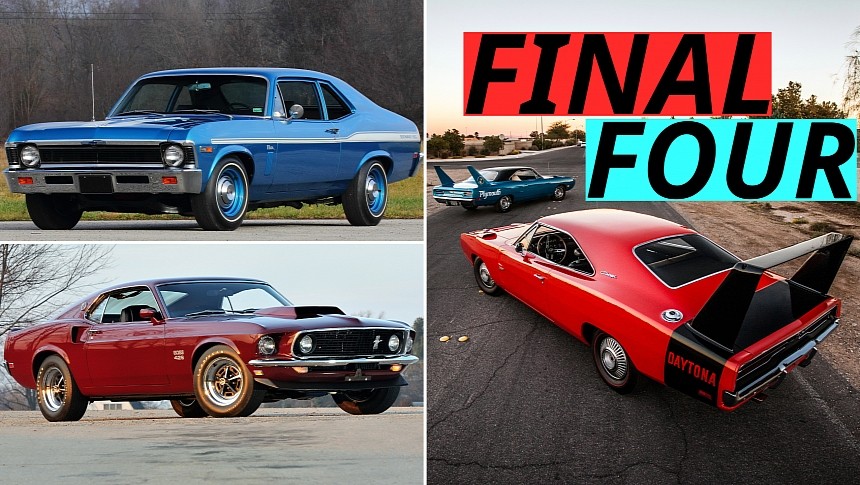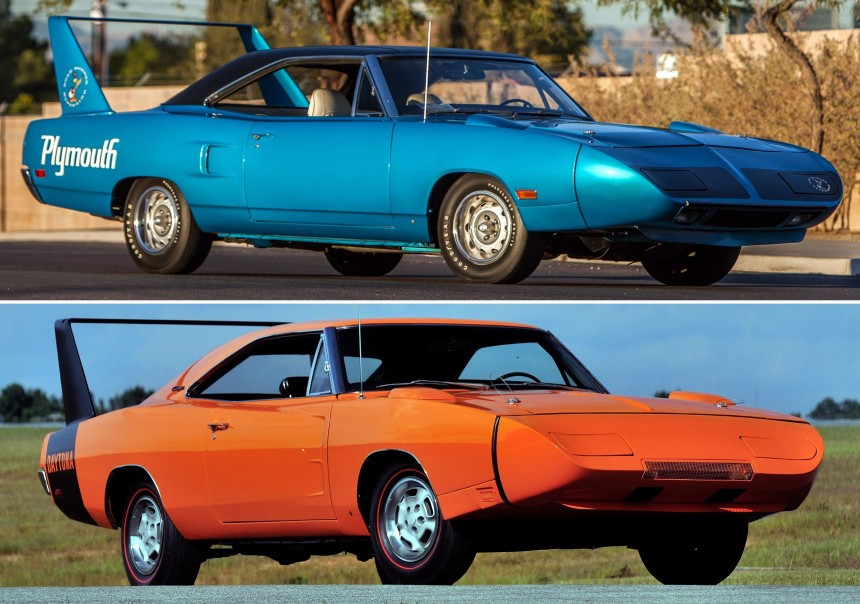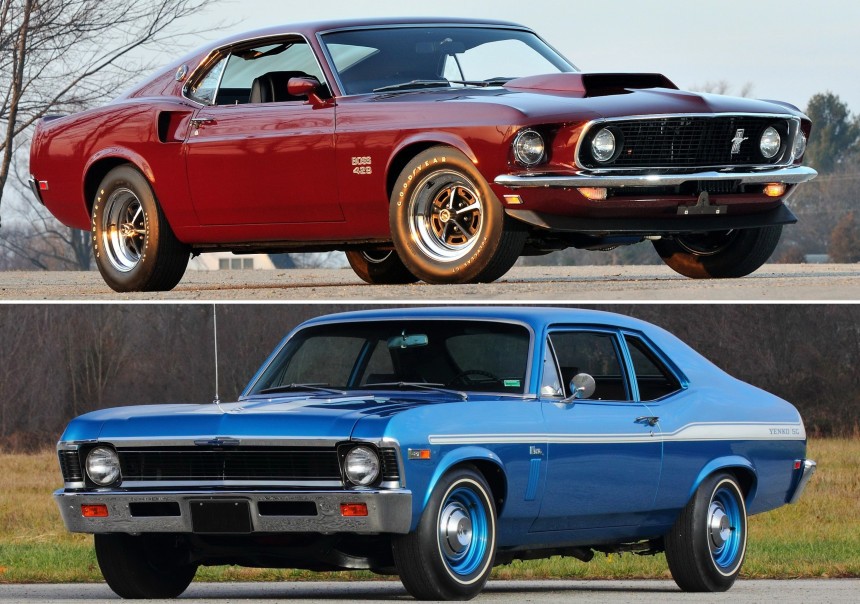We’ve finally reached the Final Four round of our “tournament”, which has fittingly transformed into a four-way battle between Ford, Chevrolet, Dodge and Plymouth. Unfortunately for us all, only two cars can advance to next week’s Super Brawl.
I think the Elite Eight round may have been a bit easier to judge than expected, apart from one or two clashes. Otherwise, the two “Wing Warriors” were never going to get beaten, and the same could be said about the 1969 Mustang Boss 429, which just so happens to have its work cut out this week.
Anyway, these are the cars that failed to make the Final Four: 1970 Plymouth Hemi ‘Cuda, 1970 Dodge Challenger R/T, 1969 Ford Mustang Mach 1, and the 1969 Chevrolet COPO Camaro ZL1. You could make a sick bracket just with those “losers” - actually, it could be fun to consider which of these cars would have had the best chance to advance if all they had to face was each other.
I can tell you with absolute certainty that the Hemi ‘Cuda would have dispatched the Challenger R/T with extreme prejudice, while the Mach 1 Mustang would have had no choice but to bow to the COPO Camaro ZL1 and its OP status.
Afterwards, we would have ended up with a Hemi ‘Cuda vs. COPO Camaro ZL1 grand finale, and this is probably when I would have zigged instead of zagged. On paper, the Camaro should win, because it’s rarer and more powerful than any flagship Barracuda. Is that enough, though? Should the all-time best muscle car be something that you’d never want to take out for a drive for fear of adding mileage and impacting its resale value? Tough choice.
I’m inclined to give it to the Hemi ‘Cuda, as far as that hypothetical finale is concerned, but I’m not going to waste too much time thinking about it, since we’ve got more pressing matters to attend to.
Today, the Plymouth Superbird is facing off against the Dodge Charger Daytona, while the Mustang Boss 429 is up against the most badass Chevy Nova imaginable. This is going to be fun.
One thing I never understood is why most people seem to agree that the Superbird is slightly better looking than the Daytona. The consensus is that while very similar in appearance, the Plymouth does hold one or two aces up its sleeve from an aesthetic standpoint. Personally, I don’t see it.
The differences are noticeable, though. Such as the Daytona having a narrow grille smack dab in the center of its nose, while the Superbird’s grille is positioned under the tip of the nose. Then there are the fender scoops, which are fake on the Superbird, but real as can be on the Daytona.
That’s right, the Dodge is the more aerodynamic of the two, which did matter once they started to put up fast laps in NASCAR. The roofs, meanwhile, are different too. All Daytonas are hardtops, while all Superbirds have vinyl roofs. As for the rear wings, the one on the Daytona is more upright (slightly).
The interiors are pretty much identical, although you do get a pistol grip shifter in the Superbird, as opposed to a ball shifter in the Daytona – I much prefer the former, so let’s give half a point to the Plymouth here.
It’s hard to call it in favor of one or the other from a visual standpoint, but if we give one of them a rating of 9.5/10, the other would have to get 9.49, and I fear it’s the Plymouth that drops .01 points in the styling department.
On the racetrack, like on the high banks of Daytona and Talladega, the Dodge held a slight 1-3 mph advantage over the Superbird, and it was all down to its superior drag coefficient of .29 cd, as opposed to the Superbird’s .31 cd. Despite this “disadvantage”, the Plymouth was technically the more successful car, winning a total of 8 races during in a single year, while the Charger Daytona needed two years to win just 6 races.
To be fair, I’m not sure how much their motorsport prowess should influence our decision here. Let’s go for... not much.
Then there’s that slight issue of which of the two is the rarer car, and once again it’s advantage Daytona. Plus, it came out before the Superbird, which can matter if you’re a wealthy collector. I couldn’t find an exact number, but it is believed that Plymouth made twice as many Superbirds compared to the Charger Daytona.
As for everyday performance, their 425 horsepower 426 ci Hemi V8 engines should provide you with all the muscle you need, even by today’s standards.
This is obviously as close a battle as they come, but choosing the Dodge over the Plymouth is ever-so-slightly more justifiable.
Winner: 1970 Dodge Charger Daytona
The rarest-possible Chevy Nova made it this far thanks to its ruggedness. Dispatching the COPO Camaro ZL1 is no small feat, and in a vacuum, the Boss 429 Mustang should be both impressed and intimidated, because this so-called Yenko Supernova was designed for straight-line battles.
It’s got a stronger frame and an upgraded suspension, to go with its 427 ci (7.0L) V8 monster of an engine, producing 425 horsepower and 460 lb-ft of torque. To make matters worse for the Mustang, only 37 units were ever produced, whereas Ford built 859 Boss 429 Mustangs to homologate that particular engine for NASCAR use.
As far as I’m concerned, the Nova Yenko story is that of an underdog. It’s freaking Rocky Balboa earning a moral victory over Apollo Creed (the COPO Camaro) in the previous round, but its opponent now is a completely different beast – and not because of its beastly qualities.
To keep the metaphor going, the Boss 429 Mustang isn’t Ivan Drago in this scenario, but rather Sylvester Stallone himself, because he’s one of those rare breeds of actors who are actually even more legendary than the characters they play on the big screen. So yes, it’s Rocky Balboa vs. Sylvester Stallone, and we’ve got to be careful how we keep score in this fight.
Now, the Nova Yenko/SC has so far relied on its rugged looks, performance, and the fact that it’s so damn rare. But it’s the underdog for a reason. Just because you’re underrated as a muscle car, doesn’t necessarily mean you’ve got the chops to knock off one of the all-time greats in the Mustang, which also happens to be the more popular choice, as opposed to more of an acquired taste.
Enough is enough, right? The Boss 429 Mustang is the people’s choice. It’s stunning from every angle, and its power unit is an absolute legend – the backstory is just as compelling, if not more so than that of any performance-package-infused Nova.
Again, Ford built this particular Mustang only so it could homologate the Boss 429 engine for NASCAR use. As such, only 859 units were made. Not super-duper rare, but rare enough to matter.
As for performance, it’s not like that 429 ci V8 is a slouch, as it produces 375 horsepower and 450 lb-ft of torque. In other words, less power, but just as much grunt as the Nova Yenko/SC.
For a moment there, I really thought the Nova could go all the way to the final (maybe even win it), like the perfect underdog that it is. But I’m afraid its journey stops here. I just can’t bring myself to say that it’s a better muscle car than the Boss 429 Mustang, and something tells me you’ll probably agree.
Winner: 1969 Ford Mustang Boss 429
So, there you have it folks. We started this journey with 32 classic American muscle cars, and we’re down to our last two. Next week’s grand finale is going to be super fun to gauge.
As always, feel free to leave a comment down below regarding all the choices we’ve made along the way, as well as which car you think should win the whole thing next week. Will it be the Boss 429 Mustang, or the Dodge Charger Daytona? It’s legend versus legend. But, in the immortal words (pun intended) of Duncan MacLeod: There can be only one.
Anyway, these are the cars that failed to make the Final Four: 1970 Plymouth Hemi ‘Cuda, 1970 Dodge Challenger R/T, 1969 Ford Mustang Mach 1, and the 1969 Chevrolet COPO Camaro ZL1. You could make a sick bracket just with those “losers” - actually, it could be fun to consider which of these cars would have had the best chance to advance if all they had to face was each other.
I can tell you with absolute certainty that the Hemi ‘Cuda would have dispatched the Challenger R/T with extreme prejudice, while the Mach 1 Mustang would have had no choice but to bow to the COPO Camaro ZL1 and its OP status.
Afterwards, we would have ended up with a Hemi ‘Cuda vs. COPO Camaro ZL1 grand finale, and this is probably when I would have zigged instead of zagged. On paper, the Camaro should win, because it’s rarer and more powerful than any flagship Barracuda. Is that enough, though? Should the all-time best muscle car be something that you’d never want to take out for a drive for fear of adding mileage and impacting its resale value? Tough choice.
I’m inclined to give it to the Hemi ‘Cuda, as far as that hypothetical finale is concerned, but I’m not going to waste too much time thinking about it, since we’ve got more pressing matters to attend to.
Today, the Plymouth Superbird is facing off against the Dodge Charger Daytona, while the Mustang Boss 429 is up against the most badass Chevy Nova imaginable. This is going to be fun.
1970 Plymouth Superbird vs. 1970 Dodge Charger Daytona
The differences are noticeable, though. Such as the Daytona having a narrow grille smack dab in the center of its nose, while the Superbird’s grille is positioned under the tip of the nose. Then there are the fender scoops, which are fake on the Superbird, but real as can be on the Daytona.
That’s right, the Dodge is the more aerodynamic of the two, which did matter once they started to put up fast laps in NASCAR. The roofs, meanwhile, are different too. All Daytonas are hardtops, while all Superbirds have vinyl roofs. As for the rear wings, the one on the Daytona is more upright (slightly).
The interiors are pretty much identical, although you do get a pistol grip shifter in the Superbird, as opposed to a ball shifter in the Daytona – I much prefer the former, so let’s give half a point to the Plymouth here.
It’s hard to call it in favor of one or the other from a visual standpoint, but if we give one of them a rating of 9.5/10, the other would have to get 9.49, and I fear it’s the Plymouth that drops .01 points in the styling department.
On the racetrack, like on the high banks of Daytona and Talladega, the Dodge held a slight 1-3 mph advantage over the Superbird, and it was all down to its superior drag coefficient of .29 cd, as opposed to the Superbird’s .31 cd. Despite this “disadvantage”, the Plymouth was technically the more successful car, winning a total of 8 races during in a single year, while the Charger Daytona needed two years to win just 6 races.
To be fair, I’m not sure how much their motorsport prowess should influence our decision here. Let’s go for... not much.
Then there’s that slight issue of which of the two is the rarer car, and once again it’s advantage Daytona. Plus, it came out before the Superbird, which can matter if you’re a wealthy collector. I couldn’t find an exact number, but it is believed that Plymouth made twice as many Superbirds compared to the Charger Daytona.
As for everyday performance, their 425 horsepower 426 ci Hemi V8 engines should provide you with all the muscle you need, even by today’s standards.
This is obviously as close a battle as they come, but choosing the Dodge over the Plymouth is ever-so-slightly more justifiable.
Winner: 1970 Dodge Charger Daytona
1969 Ford Mustang Boss 429 vs. Chevrolet Nova Yenko/SC
It’s got a stronger frame and an upgraded suspension, to go with its 427 ci (7.0L) V8 monster of an engine, producing 425 horsepower and 460 lb-ft of torque. To make matters worse for the Mustang, only 37 units were ever produced, whereas Ford built 859 Boss 429 Mustangs to homologate that particular engine for NASCAR use.
As far as I’m concerned, the Nova Yenko story is that of an underdog. It’s freaking Rocky Balboa earning a moral victory over Apollo Creed (the COPO Camaro) in the previous round, but its opponent now is a completely different beast – and not because of its beastly qualities.
To keep the metaphor going, the Boss 429 Mustang isn’t Ivan Drago in this scenario, but rather Sylvester Stallone himself, because he’s one of those rare breeds of actors who are actually even more legendary than the characters they play on the big screen. So yes, it’s Rocky Balboa vs. Sylvester Stallone, and we’ve got to be careful how we keep score in this fight.
Now, the Nova Yenko/SC has so far relied on its rugged looks, performance, and the fact that it’s so damn rare. But it’s the underdog for a reason. Just because you’re underrated as a muscle car, doesn’t necessarily mean you’ve got the chops to knock off one of the all-time greats in the Mustang, which also happens to be the more popular choice, as opposed to more of an acquired taste.
Enough is enough, right? The Boss 429 Mustang is the people’s choice. It’s stunning from every angle, and its power unit is an absolute legend – the backstory is just as compelling, if not more so than that of any performance-package-infused Nova.
Again, Ford built this particular Mustang only so it could homologate the Boss 429 engine for NASCAR use. As such, only 859 units were made. Not super-duper rare, but rare enough to matter.
As for performance, it’s not like that 429 ci V8 is a slouch, as it produces 375 horsepower and 450 lb-ft of torque. In other words, less power, but just as much grunt as the Nova Yenko/SC.
For a moment there, I really thought the Nova could go all the way to the final (maybe even win it), like the perfect underdog that it is. But I’m afraid its journey stops here. I just can’t bring myself to say that it’s a better muscle car than the Boss 429 Mustang, and something tells me you’ll probably agree.
Winner: 1969 Ford Mustang Boss 429
So, there you have it folks. We started this journey with 32 classic American muscle cars, and we’re down to our last two. Next week’s grand finale is going to be super fun to gauge.
As always, feel free to leave a comment down below regarding all the choices we’ve made along the way, as well as which car you think should win the whole thing next week. Will it be the Boss 429 Mustang, or the Dodge Charger Daytona? It’s legend versus legend. But, in the immortal words (pun intended) of Duncan MacLeod: There can be only one.









